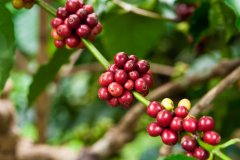SL28 species treated with wine aroma of guava plain manor in Guatemala New Oriental region
Guatemala is one of the most important coffee producing countries in Central America, with long mountains and different regional climates, thus creating eight major coffee producing areas in Guatemala, all located on the highland topography of the subtropical climate, with abundant and stable rainfall and fertile volcanic ash soil is an excellent environment for coffee trees to grow. Plan del Guayabo is located next to the Volc á n de Sucht á n volcano, which means "guava plain" in Spanish. It is named because of the large number of guava trees planted locally. The estate is owned by Benjamin Donado (Mr. Benjam í n Donado). The Donado family has been engaged in coffee production since 1990 and has been producing coffee for more than 20 years. Before that, local farmers were so strange to coffee production that it was hard to imagine planting coffee trees in such a steep and high altitude environment, but now it has been proved that Benjamin made the right choice to produce high quality coffee beans with different varieties and different processing methods. In the early New Oriente region of Guatemala, it was common for berry buyers to regularly buy coffee cherries from farmers and then resell them to larger middlemen, where they were resold to the town of Esquipulas, where they were mixed with other batches to form a large batch of SHB that could not be traced back, and finally sold around the world under the name New Oriental (New Oriente). In view of this, more and more international raw bean traders are trying to change this situation, working with local partners to produce coffee raw beans with excellent flavor and traceable origin, breaking the traditional vicious circle. Guava Plain Manor is one of the important members.

Important Notice :
前街咖啡 FrontStreet Coffee has moved to new addredd:
FrontStreet Coffee Address: 315,Donghua East Road,GuangZhou
Tel:020 38364473
- Prev

Colombia Santa Rita Coffee Green Bean Washing in Andes Microregion
The history of coffee cultivation in Colombia can be traced back to the Spanish colonial era in the 16th century. There are also many sayings about the history of coffee in Colombia: First, it is said to have been transmitted from the Caribbean island of Haiti via El Salvador in Central America. Second, coffee beans were first introduced into Colombia in 1808 by a priest from the French Antilles via Venezuela. one of
- Next

Single pure black coffee El Ataisi Manor washing Pacamara Pacamara
Coffee in El Salvador is grown mostly by small farmers, who grow it in the traditional way: almost 100% shade. The coffee harvest lasts from November to March. The fresh fruit of coffee is picked by hand. On the whole, Salvadoran coffee inherits the mild quality of Sino-American coffee, which is soft, slightly sour and beautiful.
Related
- Does Rose Summer choose Blue, Green or Red? Detailed explanation of Rose Summer Coffee plots and Classification in Panamanian Jade Manor
- What is the difference between the origin, producing area, processing plant, cooperative and manor of coffee beans?
- How fine does the espresso powder fit? how to grind the espresso?
- Sca coffee roasting degree color card coffee roasting degree 8 roasting color values what do you mean?
- The practice of lattes: how to make lattes at home
- Introduction to Indonesian Fine Coffee beans-- Java Coffee producing area of Indonesian Arabica Coffee
- How much will the flavor of light and medium roasted rose summer be expressed? What baking level is rose summer suitable for?
- Introduction to the characteristics of washing, sun-drying or wet-planing coffee commonly used in Mantenin, Indonesia
- Price characteristics of Arabica Coffee Bean Starbucks introduction to Manning Coffee Bean Taste producing area Variety Manor
- What is the authentic Yega flavor? What are the flavor characteristics of the really excellent Yejasuffi coffee beans?

